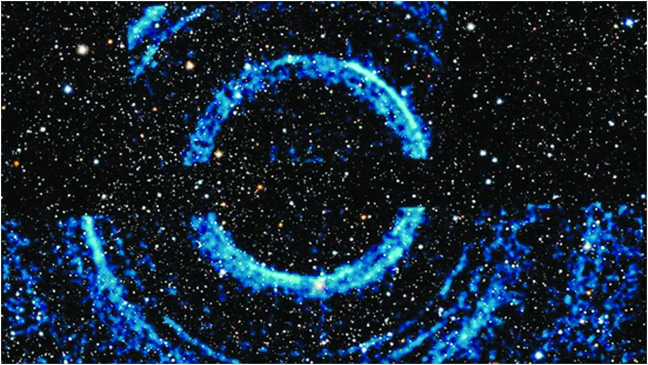
Astronomers have spotted a spectacular set of rings around a black hole in an image captured using Nasa‘s Chandra X-ray Observatory and Neil Gehrels Swift Observatory. Nasa said that the X-ray images of the giant ring reveal information about the black hole, its companion star, and the intervening dust clouds.
“The black hole is part of a binary system called V404 Cygni, located about 7,800 light-years away from Earth. The black hole is actively pulling material away from a companion star — with about half the mass of the Sun — into a disk around the invisible object. This material glows in X-rays, so astronomers refer to these systems as “X-ray binaries,” the US space agency said.
In 2015, Neil Gehrels Swift Observatory discovered a burst of X-rays from V404 Cygni creating high energy rings. These rings were generated when a burst of X-rays from the black hole system bounced off of dust clouds between V404 Cygni and Earth, a phenomenon called light echoes. Cosmic dust consists of tiny, solid particles.
The rings tell astronomers about the landscape between V404 Cygni and Earth. According to Nasa, the diameter of the rings reveals the distances to the intervening dust clouds the light ricocheted off. When the cloud is closer to Earth, the high energy ring appears larger and vice versa.
“The light echoes appear as narrow rings rather than wide rings or haloes because the X-ray burst lasted only a relatively short period of time,” said Nasa.
NASA Mars rover fails to collect rock in search of alien life
NASA’s Perseverance drilled into the surface of Mars but failed in its initial attempt to collect rock samples that would be picked up by future missions for analysis by scientists on Earth.
The US space agency published images Friday of a small mound with a hole in its center next to the rover — the first ever dug into the Red Planet by a robot.
But data sent to Earth by the rover after its first attempt to collect a sample and seal it in a tube indicated no rock had been gathered.
“While this is not the ‘hole-in-one’ we hoped for, there is always risk with breaking new ground,” said Thomas Zurbuchen, associate administrator for NASA’s science mission directorate, in a statement.
“I’m confident we have the right team working this, and we will persevere toward a solution to ensure future success.”
The drill hole is the first step of a sampling process that is expected to take about 11 days, with the aim of looking for signs of ancient microbial life that may have been preserved in ancient lakebed deposits.
Scientists also hope to better understand Martian geology.
The mission took off from Florida a little over a year ago and Perseverance, which is the size of a large family car, landed on February 18 in the Jezero Crater.
Scientists believe the crater contained a deep lake 3.5 billion years ago, where the conditions may have been able to support extraterrestrial life.
NASA plans a mission to bring around 30 samples back to Earth in the 2030s, to be analyzed by instruments that are much more sophisticated than those that can be brought to Mars at present





Be the first to comment